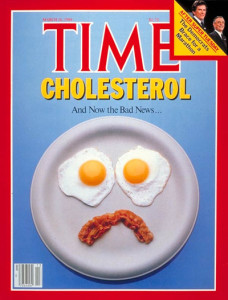Meet the modern inflammatory diet.
We are fatter and sicker—and extremely unhappy about being fatter and sicker—than ever before in history. Except, of course, anyone who has tried to actually do something about their health but given up—moving into the “nothing can be done about it” band.
The studies are clear: where “modern” processed foods become the standard diet, obesity, type 2 diabetes, heart disease, cancer and other diseases of inflammation follow.
When we abandon our traditional nourishing foods in favor of processed groceries high in sugar, processed grains, vegetable oils, and additives, we get sick.
Of the top ten causes of death in this country, if you remove the 103,000 deaths caused by medications / medical procedures gone wrong and also remove the 130,000 deaths by unintentional accidents and injuries, the remaining top ten have inflammation as their root cause:
 Heart disease: 611,105
Heart disease: 611,105- Cancer: 584,881
- Chronic lower respiratory diseases: 149,205
- Stroke (cerebrovascular diseases): 128,978
- Alzheimer’s disease: 84,767
- Diabetes: 75,578
- Influenza and Pneumonia: 56,979
- Nephritis, nephrotic syndrome, and nephrosis: 47,112
The ability to do the things we love requires properly nourishing our body so that when we want to play with our children, ski, hike, or even get out of bed—the body can actually follow through. Health, energy, weight control… these all depend on ignoring the marketing and other hype.
Since their release in 1977, the Dietary Guidelines for US have remained fairly consistent in their message:
- Increase consumption of fruits, vegetables, and whole grains;
- Decrease consumption of: refined and processed sugars and foods high in such sugars;
- Eat fewer foods high in total fat and animal fat, and partially replace saturated fats with polyunsaturated fats;
- Eat fewer eggs, butterfat, and other high-cholesterol foods;
- Reduce salt and foods high in salt; and
- Choose low-fat and non-fat dairy products instead of high-fat dairy products (except for young children).
Every five years by committee new Guidelines have been released and within them revised goals with very specific numbers of exactly how much each person should consume. Each release of a new set of dietary goals has been met with considerable debate and controversy. Industry groups debate the scientific community saying the available science doesn’t support the specific numbers in the goals.
What’s wrong with our nourishment?
Two main major food groups (carbohydrates and fats) are not only being eaten disproportionately backwards, the selection made possible by cheap processed foods is sending our immune system on a rampage. We are taught to avoid foods that are healthy and eat foods that are not. Let’s take a look:
1. Syrocketing sugar intake in the past two centuries
The developed world consumes up to 150 lbs (67 kg) of sugar per person per year—some 500 calories of sugar per day—of absolutely no nutritional value, just empty calories. This does not include sugar found naturally in fruits or vegetables.
One problem is that elevated blood sugar is toxic. Study after study in people shows how eating in a way that rollercoasters blood sugar will cause severe metabolic problems, including insulin resistance, metabolic syndrome, elevated cholesterol and triglycerides, hormone imbalances and more. Added sugar drives diseases like obesity, type 2 diabetes, heart disease and even cancer.
Even the U.S. dietary guidelines issued in 2010 recommend limiting the consumption of foods and beverages with added sugars—not that I’ve seen any changes to the amount of sugar being added to every boxed or canned food from chicken broth to baby food… but now it is officially recommended.
2. Oh how we love our sugary drinks
 Over half the US population over 2 years old drinks one or more sugary drink every day.
Over half the US population over 2 years old drinks one or more sugary drink every day.
- Males consume more sugar drinks than females.
- Teenagers and young adults consume more sugar drinks than other age groups.
- Approximately one-half of the U.S. population consumes sugar drinks on any given day.
- Non-Hispanic black children and adolescents consume more sugar drinks in relation to their overall diet than their Mexican-American counterparts. Non-Hispanic black and Mexican-American adults consume more than non-Hispanic white adults.
- Low-income persons consume more sugar drinks in relation to their overall diet than those with higher income.
- Most of the sugar drinks consumed away from home are obtained from stores and not restaurants or schools.
We’ve been lead to believe that fruit juice is “OK” or even “healthy.” Sadly, fruit juice and “fruit juice sweetened” contributes the same amount of sugar as most soft drinks. Usually, bottled and canned fruit juice is a heated, refined fructose sugar—the food is not the original, living form.
- What’s worse, fructose directly leads to
- inflammation,
- heart disease,
- metabolic syndrome,
- obesity, and
- gout.
And getting sugar in liquid form may be particularly harmful. Studies show that the brain doesn’t “register” liquid sugar calories or feel satisfied—people still eat the size breakfast, lunch, and dinner after drinking a sweetened beverage. This dramatically increases total calorie intake and has been shown to be linked to obesity and diabetes.
In children, sugar-sweetened beverages increase risk of obesity by as much as 60%; sugary juices also make children shorter.
3. We listened dutifully to the Low-Fat Dietary Guidelines
Published in 1977, most researchers now believe following the low-fat mantra is more than just merely a coincidence with the massive increases in inflammatory diseases.
But isn’t low fat heart healthy? Doesn’t it protect from cancer? Not according to the numerous and large studies conducted since the guidelines were published show that a low fat diet is no better at preventing heart disease in women or in men, or cancer than the standard Western diet (which has resulted in very high cancer and heart disease rates).
And what about obesity? Good question… women who stopped the Standard American Diet of high carbs and low fat and returned to a diet higher in fats, vegetables and fruit lost weight and kept it off.
Why are we still being advised to follow this type of diet, despite the studies showing it to be completely ineffective?
4. It’s not just any fat…
Dr. Stephan Guyenet. The American Diet. 2012.
…it’s saturated fats, right?
The anti-fat message essentially put the blame on saturated fat and cholesterol, while giving sugar and refined carbs a free pass. But fat makes food taste good and leads to our sense of satiety. If the fats have to go… to make the food taste remotely interesting they add sugar, salt, flavors…
When the media started blaming saturated fat for heart disease, we also all abandoned traditional fats like butter, lard and coconut oil in favor of processed vegetable oils. The Dietary Guidelines for Americans—jointly published by the U.S. Department of Agriculture (USDA) and the Department of Health and Human Services (HHS) every five years—have had a profound influence on the foods produced and consumed.
Of course the actual studies never really showed fat was unhealthy… and, of course if you’d bought futures in soy, corn, safflower, canola… you’d want to protect your income…
The evidence reviewed in a nutshell:
- Eating high levels of saturated fat has no effect on coronary disease (32 observational studies; 530,525 participants)
- Blood levels of saturated fatty acids were not associated with coronary disease.
The health problems of removing saturated fat
5. Soybean oil is a major source of calories
The 20th century economics saw a >1,000-fold increase in the estimated per capita consumption of soybean oil from 0.006 to 7.38% of energy making soy oil the most-consumed vegetable oil in the U.S. Most of us don’t realize how much soybean oil we are getting as most of it is used in processed foods.
Soy (and corn and peanut and other seed) oils are very high in omega-6 fatty acids—one of the poly-unsaturated fats that we can’t make in our body; another is omega-3. A healthy diet provides about the same amount of omega-6 and omega-3 fatty acids to provide the body with various building blocks. Wild fish (but not farmed; soy and corn-fed), grass-fed cows (but not soy and corn-fed), and eggs from pastured chickens (but not commercially-raised soy and corn fed) are the best source of dietary omega-3 fatty acids.
Except we were told to skip our saturated fats and high-cholesterol eggs. And except we are in such a hurry that everything comes out of a quick box laden with a cheap seed oil.
Today, the US diet is about 40:1 omega-6:omega-3 fatty acids.
Omega-6 fatty acids generally make hormones that signal inflammation in the body (like prostaglandins) and which can contribute to inflammation-related diseases like osteoporosis, cancer and heart disease. Omega-3 fatty acids tend to make anti-inflammatory and mood stabilizing hormones.
The misguided advice to avoid saturated fat and choose vegetable oils instead may have actually fueled the heart disease epidemic.
6. Replacing heart-healthy fats with… the low-fat fad: changing the fats in cows, their milk, chickens and us
Most of the omega-6 fats in seed oils are a fatty acid called linoleic acid—a fat that we need to make prostaglandins and other hormones—and we must get it from our diet. Most of the omega-6 linoleic acid that makes it through your blood to your cells is made into prostaglandins (associated with inflammation and pain) or stored.
Diets high in seed oils (like the Standard American Diet following low saturated fat recommendations) gradually result in fat imbalances; including the fats in our cells and blood. After three years comparing seed oil (high in omega-6 linoleic acid) versus a diet high in saturated fats (and omega-3):
- Body fat composition was similar to the type of fat eaten (e.g. seed consumption raised linoleic acid)
- The seed-oil group gained weight
- The saturated fat diet had lower blood cholesterol
- The omega-6 fat diet resulted in blood triglycerides high in inflammatory linoleic acid
7. Gut health failure
If you have a balanced gut ecosystem—meaning a healthy balance of all five probiotic families and hundreds of their variant strains—then these symbiotic friends covert some of the dietary linoleic acid into a healthier form of “conjugated linoleic acid.” There are about 28 forms of conjugated linoleic acid including some that are unhealthy trans-fats.
Probiotic microbes also break down other fats into short chains with healing properties. Eating too many sugary or starchy foods imbalances the gut microbiome.
The plot thickens… cows also depend on gut probiotics to make conjugated linoleic acid—strains that cannot exist in the ruminant gut if fed grains. Not surprisingly, cows fed grains also have high levels of linoleic acid in their meat (which you then eat) and lower levels of conjugated linoleic acid in their milk replaced by pro-inflammatory linoleic acid. Although not a seed oil, per se, the fat composition of grain-fed animals—even those just grain-finished for a few weeks—is altered from healthy.
Unfortunately, over the 20th century, chickens, cows, and us are increasing our levels of stored linoleic acid, and with that becoming fatter, more inflamed, not as able to think clearly and more irritable. This all may be connected. In 2012, researchers showed the link between increased tissue linoleic acid, chronic inflammation of fat, liver and brain tissues, and the exact biochemical path through which it all happens.
They also showed that as people ate more linoleic acid-containing foods like seeds, soy or grain-fed chickens, obesity and signs of inflammation skyrocketed.
 8. Replacing heart-healthy butter with trans-fats
8. Replacing heart-healthy butter with trans-fats
Perhaps the saturated fat war had to happen to justify the introduction of margarine. During the second world war, cheap products from corn dominated. Margarine was made by taking unsaturated seed oils and chemically adding hydrogens to “saturate” them and make them more solid. Unfortunately, the chemistry doesn’t result in a healthy version of saturated fats. Instead, we get trans fats—oddly shaped, kinked, and often crosslinked in ways that the body doesn’t recognize as any food or energy source.
Too many to count studies show that trans fats increase the risk of heart disease where naturally-occurring saturated fats do not. Butter from 100% grass-fed cows has a number of nutrients that protect against heart disease (like Vitamin K2).
 9. Avoiding eggs and cholesterol
9. Avoiding eggs and cholesterol
Eggs are among the most nutritious foods on the planet.
Despite what you’ve heard, eating eggs won’t raise your blood cholesterol.
There is no evidence that eating eggs contributes to heart disease.
The dietary recommendations proposed in the 1960s after Time Magazine interpretations of work by Ancel Keys MD and, later, the Framingham study, greatly oversimplified a complicated matter. Blood pressure elevations are unquestionably a heart disease problem. Cholesterol levels above 240mg/dL may correlate (as opposed to cause) heart disease, but lower levels make no difference. Eating saturated fat? Villainous, horrible, and the dietary guidelines published since 1977 continue to tell us to stop eating saturated fats, reduce our eggs and somehow our cholesterol levels will go down and our heart health up.
 The problem is and always has been the quality of the fat—whether saturated, unsaturated, or otherwise, certain fats create an inflammatory response. We are eating too many of these. Worse, we cut out healthy fats and added sugar.
The problem is and always has been the quality of the fat—whether saturated, unsaturated, or otherwise, certain fats create an inflammatory response. We are eating too many of these. Worse, we cut out healthy fats and added sugar.
Removing all fats violates the dietetics and nutritionist mantras that only fad diets would ever remove entire food groups.
10. Listening to media not science we cut out healthy fats and added sugars and starches
This just in… eat more butter
Nearly four decades after these guidelines, the human experiment was a failure. We cut the fat, but by almost every measure:
- Americans are sicker than ever.
- Type 2 diabetes increased 166% from 1980 to 2012 costing the health care system $245 billion a year.
- An estimated 86 million people are prediabetic.
- Deaths from heart disease have fallen–probably due to better emergency care and fewer of us smoking–but cardiovascular disease remains the country’s No. 1 killer.
- More than a third of U.S. residents are obese, making the U.S. one of the fattest countries in an increasingly fat world.
There’s an overwhelmingly strong case to be made for a paradigm shift.
But it will take an enormous change in these messages in order to get enough people to embrace the importance of lifestyle behavior change and set truly evidence-based standards for effective nutrition and lifestyle services.
References (additional to in-text hyperlinks)
Johnson RJ, et al. Potential role of sugar (fructose) in the epidemic of hypertension, obesity and the metabolic syndrome, diabetes, kidney disease, and cardiovascular disease. The American Journal of Clinical Nutrition, 2007.
Low Fat Dietary Guidelines: National Center for Health Statistics (US). Health, United States, 2008: With Special Feature on the Health of Young Adults. Hyattsville (MD): National Center for Health Statistics (US); 2009 Mar. Chartbook.









This was a very interesting article and quite informative. I’m looking for more information on how inflammation affects the body, can you tell me where to look?
Hi Bill! Sure,
1. use the search function on each page of this website. Type “inflammatory” or “inflammation” and see what comes up.
2. check out Dr. Stephen Guyenet’s blog over at http://wholehealthsource.blogspot.com/ –he is brilliant and looks at the original scientific literature when forming his thoughts and articles; not someone’s boiled down urban legend aimed at selling products or programs but just based on worn out ideas.
3. ask me a more specific question and I’ll see what there is to say–maybe a subject for my next article?
Stay Brilliant!
Marie